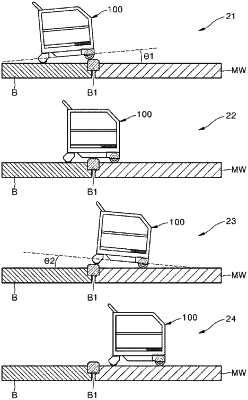| CPC B25J 9/1633 (2013.01) [B25J 9/161 (2013.01); B25J 9/1676 (2013.01); B25J 13/085 (2013.01)] | 17 Claims |

|
1. A cart robot for controlling movement in response to a change in a travel surface using artificial intelligence, the cart robot comprising:
a plurality of moving parts configured to move the cart robot;
an obstacle sensor configured to sense an obstacle near the cart robot;
an inertial measurement unit (IMU) sensor configured to sense the change in the travel surface of the cart robot;
a force sensor configured to sense a change in force applied to a handle assembly of the cart robot; and
a controller configured to control a direction or a speed of movement of the plurality of moving parts depending on the change in the force sensed by the force sensor,
wherein when the IMU sensor senses the change in the travel surface, the controller controls the obstacle sensor such that the obstacle sensor senses a distance from an installed object placed in a direction in which the cart robot advances, calculates a time point at which the cart robot moves out of the travel surface and increases magnitude of electric energy to be supplied to the plurality of moving parts at the time point at which the cart robot moves out of the travel surface,
wherein the change in the travel surface is caused by the cart robot's entry to a moving walkway,
wherein the IMU sensor senses a gradient of the cart robot, caused by a difference between heights of a moving part at a front and a moving part at a rear of the cart robot, after the change in the travel surface, and
wherein when the distance sensed by the obstacle sensor at a front of the cart robot is a predetermined exit distance reference value or greater, and a tilt angle of the cart robot decreases, the controller increases the magnitude of the electric energy to be supplied to the plurality of moving parts in proportion to the force sensed by the force sensor.
|